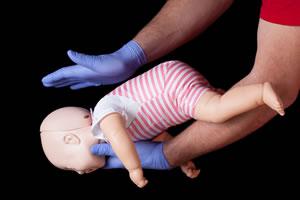Like adults, children and babies also are at risk from choking.
A choking baby is every parent’s biggest fear but it is also a serious risk to those that work in child care. At TutorCare we offer courses covering a wide range of First Aid topics including Basic Paediatric First Aid Training that includes training on how to deal with a child choking.
Depending upon the childs age there are two different approaches to choking.
The following is a guide only outlining the steps a trained adult can take to stop a child or baby from choking.
Please do not follow these steps unless you have attended a certified course.
A video released by the NHS can be seen here
If the baby / child is under one year old:
Step One – Perform 5 back blows;
Hold the baby face down, across your lap, with their head lower than their bottom.
Support the baby’s head by holding either side of their jaw, ensuring care is taken not to put pressure on their throat or neck.
Using the heel of your hand, firmly slap the baby’s back, in between their shoulder blades, up to 5 times.
Between each slap, pause and check if the blockage has cleared.
If the blockage has cleared discontinue administering the blows to the back.
If the airway remains blocked after 5 taps move onto Step Two.

Step Two: Chest Thrusts;
Put the baby on their back, either on your knees or on the floor (any flat surface).
Locate the breast bone, placing two fingers on teh lower half of the breastbone make 5 sharp chest thrusts, compressing the chest to about a third with each thrust.
Between each thrust, check if the airway is cleared;
If the airway is cleared discontinue the chest thrusts.
Repeat the cycle. If the airway is not cleared after three cycles, call 999.

If the infant is over one year old:
Step One – Perform 5 back blows;
Lay the infant down on your lap as you would a baby. If this isn’t possible, support the child in a forward-leaning position and give five back blows (to the upper back) from behind.
If back blows don’t relieve the choking and your baby or child is still conscious, move on to Step Two.
Step Two – Abdominal Thrusts;
Kneeling behind the infant, wrap your arms around the upper abdomen, placing your arms under their arms.
Hold your closed fist just under their ribcage above their naval.
Hold your fist with your other hand and pull back towards you and upwards sharply.
Be careful not to push against their rib cage as this may cause damage.
Repeat the cycle. If the object is not dislodged after three cycles call 999.
Key Points in an Emergency
Call for help if you are alone.
If you can see the object, try to retrieve it with your hands. Don’t put your fingers in the child’s mouth if you can’t see the object; you may push if further in.
When you call 999, make sure you phone is on hand free so you can talk while your peform any actions the emergency services tell you to.
Do not leave the child unattended.
If you have managed to remove the blockage you should still take the child / baby to see a doctor to ensure they have not suffered any injuries during the back blows or chest thrusts.
